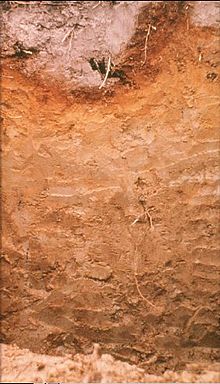Spodosol
As Spodosole be designated according to the USDA Soil Taxonomy strongly acidic soils , resulting from mostly sandy have formed the starting material. Spodosols are mainly found in the northern hemisphere in regions with a cold, humid climate, especially in eastern Canada , Scandinavia and north-western Russia . They can be roughly correlated with the Podzolen of the WRB and the Podzolen of the German Soil Systematics .
The soil texture is mostly coarse-grained so that water can run off very easily. It leaches out the upper soil horizons and carries the humus it contains into lower horizons. This creates the characteristic bright A-horizon of the soil, which is strongly acidic and poor in minerals due to the loss of water-soluble basic components. Underneath is a darker, humus-containing horizon, which is often colored red by iron and aluminum oxides washed in. The latter are often brought deeper by organic acids and then form another, now light orange colored horizon, which is typical for Spodosols.
The natural vegetation on Spodosolen is coniferous forest - the majority of the organic acids that are responsible for the low pH value of the soil come from the fallen and then slowly rotting needles of the coniferous plants growing there . It can only be used agriculturally after using fertilizers and liming for neutralization. Due to the relatively large gaps between individual grains of the soil, spodosols are particularly rich in nematodes .
Worldwide there are around 3.4 million square kilometers of land covered by spodosols, which corresponds to 2.6 percent of the ice-free land area.
classification
Spodosols are divided into five sub-categories:
Web links
literature
- Soil Survey Staff: Soil Taxonomy: A Basic System of Soil Classification for Making and Interpreting Soil Surveys. 2nd edition. Natural Resources Conservation Service. US Department of Agriculture Handbook 436.Washington DC, USA, 1999.
- Soil Survey Staff: Keys to Soil Taxonomy. 12th edition. Natural Resources Conservation Service. US Department of Agriculture. Washington DC, USA, 2014.
